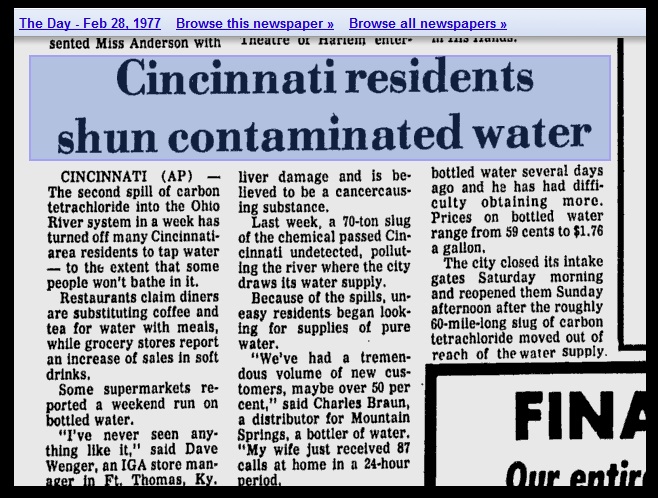Cincinnati city officials sent out letters to 16,000 residents this week, informing them that much of the city’s water transporting pipes are still made of lead.
The message is kind of contradictory, admitting the pipes are problematic, while assuring residents that it’s safe because they have a “successful lead corrosion control program.”
According to Cincinnati.com:
City leaders here in Cincinnati don’t want citizens to panic. Greater Cincinnati Water Works closely monitors its water and has never had a lead violation, according to officials. Cincinnati has had a successful lead corrosion control program that has protected customers for years.
But the pipes’ mere existence can cause a threat, officials confirm.
The elected bureaucrats of Flint, Michigan hesitated to inform residents about contaminated water for as long as they possibly could; knowing how officials can be, is this a sign that Cincinnati water is already dangerous?
Perhaps to save their reputation, they will disclose to some extent the condition of Cincinnati water?
To know the real condition of Cincinnati’s water at various parts of the city, one would have to talk to actual residents, or do some independent chemical testing.
The most insightful, down-to-earth information about Flint’s water contamination crisis comes from grassroots, community organizations, like New Era Detroit.
New Era Detroit delivered truckloads of fresh water to Flint residents, and interviewed them to get their firsthand experiences out to the public via alternative media.
This man’s firsthand account, in tears, describing how his son sustained chemical burns from trying to bathe in the Flint water, goes to show that the mainstream media and officials are nowhere near recognizing the true extent of the damage.
Heart breaking testimony from a Flint resident
Posted by Keith Horton on Friday, January 29, 2016
What is the chemical in Flint’s water responsible for burning people’s skin? Who knows, that’s the kind of thing one can only learn from firsthand experience, or a genuine, alternative media outlet being a vessel for that firsthand experience.
This wouldn’t be the first milestone in Cincinnati’s contaminated water history. Land of the Rockefellers, Ohio, has long been a dumping ground for industry like many other Midwest states.
A newspaper from 1977 can be found at this link, reporting on carbon tetrachloride spilling into the Ohio River system, contaminating the water.
 Just a few years ago, we could see the Weather Channel headline “Cincinnati To Stop Using Water From Ohio River as Chemicals from West Virginia Spill Move Downstream.”
Just a few years ago, we could see the Weather Channel headline “Cincinnati To Stop Using Water From Ohio River as Chemicals from West Virginia Spill Move Downstream.”
The article says:
Cincinnati plans to shut down intake valves along the Ohio River to protect the city’s drinking water from a chemical spill in West Virginia.
Mayor John Cranley announced Monday that the valves will be shut down for at least 20 hours beginning Tuesday night. Cranley says that will allow the water to pass the city without any chemicals entering the drinking supply.
On Thursday, a chemical used in coal processing leaked from a plant into the nearby Elk River in Charleston, W.Va. The Elk River feeds into the Ohio River.
The spill caused a dayslong crisis in which officials banned the use of tap water for some 300,000 people.
Particularly in the American Midwest we see the residual decay, toxic footprint of industry still. Rarely are the individuals or corporations responsible held accountable, and acquiring a complete perception of just what this means is not easy unless a person is affected by it dramatically, firsthand, like having a family member receive a life-threatening illness from it.
 Ask the residents of Flint who are getting mysterious, life threatening diseases such as “Legionnaires’ Disease,” if this is a life and death situation.
Ask the residents of Flint who are getting mysterious, life threatening diseases such as “Legionnaires’ Disease,” if this is a life and death situation.
A particular industry or company cannot necessarily be implicated in the contamination of Cincinnati’s water (or maybe it can and we just don’t know who it is yet), but if that could be pinpointed, this is a life and death situation.
Poisoning a water supply is a life or death situation, accidental or not, and residents must treat it as such, and hold those who are responsible accountable as if they put people’s lives on the line.
This is something that would be considered an act of war if it were found to be deliberate.
This article (16,000 Cincinnati Residents Receive Warning About Lead Pipes, Water Contamination) is free and open source. You have permission to republish this article under a Creative Commons license with attribution to Era of Wisdom.org.


Be the first to comment on "16,000 Cincinnati Residents Receive Warning About Lead Pipes, Water Contamination"